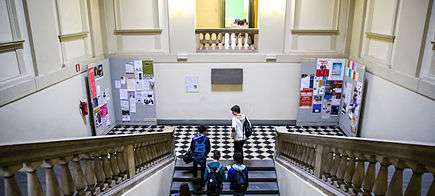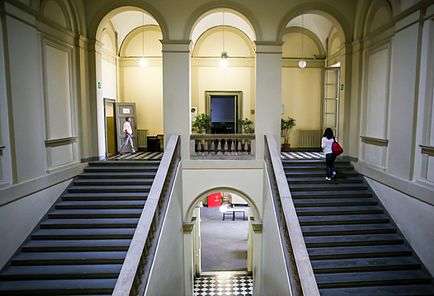Liceo Classico Paolo Sarpi in Bergamo


The Liceo Classico statale "Paolo Sarpi" is the oldest Liceo classico in Bergamo (since 1803) and one among the oldest and most prominent high schools in Italy, for pupils aged 14 to 19. The neolassical building of the Liceo Sarpi was designed by the architect Ferdinando Crivelli in 1842. The school is situated in the Upper Town of Bergamo (Città alta).
History
The history of the classical teaching in Bergamo is included in the schools of the Congregazione della Misericordia Maggiore, which gave Bergamo the istruction. The first public school of grammar, humanities and rhetoric dates back to 1506; it became Accademia della Misericordia in 1566 and, abolished in 1610, rivived in 1617 with the name Nuova Accademia della Misericordia. Completely worn out because of the 1630 plague, the school cheered up again with the name Collegio Mariano from Ambrogio Mariano who in 1663 was charged with doing the restoration of the building, in current Via Arena. Entrusted to Barnabites in 1700, the Collegio Mariano was subordinated to Napoleon. He decided to close the religious school. His reform of the institution collided with teacher, who remained in service.
The lyceum was established in Napoleonic epoch on the 15 November 1803. It was situated in Via Arena - in the building of the Misericordia Maggiore - not far from the current one.

The Municipality of Bergamo (Comune di Bergamo) assigned the Convento della Clarisse as the permanent location of the Lyceum, in 1816. The convent was demolished (1844). On the site, the current building was erected between 1845 and 1852. It was designed by the architect Ferdinando Crivelli.
Following the Italian Unification, a 1865 royal decree ordered to entitle the Lyceum to Paolo Sarpi.
Since its establishment, the Liceo Classico Paolo Sarpi obtained a prestigious role both in the City and in the Region, because of the professionalism and the strictness of its education.
Recently some reforms have occurred in the education:
- in 1989 the Liceo adopted the continuation of the foreign language learning in the triennium;
- in 1990 the Liceo adhered to the National Plan for Computer Science, aimed at the modernization of mathematics as well as elements of computing;
- in 1996 it approved the experimentation of cultural heritage studies and history of art;
- in 1998 it realized the Hermes project, an experimentation of the autonomous pedagogy, aimed at reorganizing new ways for developing recovery activities;
- since 2002, within the Languages branch, a musical programme had been adopted (until 2014).
 The skyline of the Upper Town of Bergamo. The Liceo Classico Paolo Sarpi building is on the left of the picture.
The skyline of the Upper Town of Bergamo. The Liceo Classico Paolo Sarpi building is on the left of the picture.
Subjects
| Subjects | 1º Biennial | 2º Biennial | V year | ||
|---|---|---|---|---|---|
| I year | II year | III year | IV year | ||
| Italian language and literature | 4 | 4 | 4 | 4 | 4 |
| Latin | 5 | 5 | 4 | 4 | 4 |
| Ancient Greek | 4 | 4 | 3 | 3 | 3 |
| English | 3 | 3 | 3 | 3 | 3 |
| History and Geography | 3 | 3 | - | - | - |
| History | - | - | 3 | 3 | 3 |
| Philosophy | - | - | 3 | 3 | 3 |
| Mathematics* | 3 | 3 | 2 | 2 | 2 |
| Physics | - | - | 2 | 2 | 2 |
| Natural science** | 2 | 2 | 2 | 2 | 2 |
| History of Art | - | - | 2 | 2 | 2 |
| Physical Education | 2 | 2 | 2 | 2 | 2 |
| Catholic Religion Instruction or other activities[1] | 1 | 1 | 1 | 1 | 1 |
| Weekly lesson hours | 27 | 27 | 31 | 31 | 31 |
- *with Computer Lab at first biennial
- **Biology, Chemistry and Earth science
Statistics: the 2015 Ministerial Report
A 2015 report[2] of the Italian Ministry of Education, Universities and Research highlighted the excellence of the students in Humanities and Mathematics (INVALSI national exam 2013/14). The score of tests INVALSI in Mathematics is higher than other schools with socio-economic background and similar and above the Italian national average.[3] (Page 26) The number of students with the debito (remedial/make-up) is still too high (24% of students counted). But above all, the criteria of policies adopted by the school does not allow teachers to award top marks (9-10), causing a concentration (especially in the three final years) in the middle band of marks 6-8: marks 9 and 10 are too rarely awarded. Also the number of drop-outs must be reduced.[4] (Page 21)
The observed data give an excellent evaluation in relation to the national situation.[5] (Page 26) The report recognized the excellence of the preparation of the students of the Liceo Classico Paolo Sarpi, above the Italian national average. Though, the data said the marks are under the Italian average.
About the working competences, it said: The institute, even for secular vocation, not orients immediately to the world of work, while forming the future ruling class. Must therefore be strengthened apprenticeships involving all students the second two years.[6] (Page 36). The Institute especially develops the knowledge and skills needed to study at university.[2] (Page 36)
Curiosities
The palace of the Liceo Classico Paolo Sarpi has been used as set of several movies:
"Gli anni e i giorni", Oki-Doki film, Beppe Manzi, 2011.
"Una grande famiglia", Riccardo Milani for Rai Uno, 2012.
Notable alumni
Roberto Calderoli, Italian politician, former vice president of the Italian Senate of the Republic
Filippo Maria Pandolfi, Italian politician, exponent of Christian Democracy, Minister of Agriculture, Minister of the Industry, twice Minister of Treasury. European commissioner for Research, Innovation and Science
Bortolo Belotti, Italian politician
Roberto Bruni, former Mayor of Bergamo
Carlo Cremaschi, Italian partisan and spokesperson of Christian Democracy
Giuliano Donati Petténi, poet and writer
Vittorio Feltri, Italian journalist
Giorgio Gori, Mayor of Bergamo and exponent of Democratic Party
Giorgio Jannone, exponent of Forza Italia
Giacomo Suardo, President of the Senate of the Kingdom of Italy (1939-1943)
Franco Tentorio, former Mayor of Bergamo, exponent of National Alliance
Mirko Tremaglia, Italian politician, exponent of National Alliance, Minister of the Republic
Aldo Amati, Italian diplomat
References
- ↑ namely, for students who decide not to follow this course
- 1 2 "RAV rapporto di autovalutazione - Liceo Classico Statale Paolo Sarpi" (PDF). Retrieved 27 November 2015.
- ↑ "RAV - rapporto di autovalutazione - Liceo Classico Sarpi 2015" (PDF).
- ↑ "RAV Certificato di autovalutazione 2015" (PDF). 2015.
- ↑ "RAV 2015 - Rapporto di autovalutazione Sarpi" (PDF).
- ↑ "RAV 2015 - Liceo Classico Paoo Sarpi" (PDF).
External links
- "Liceo Sarpi has to repeat the INVALSI tests: students are too smart" - L'eco di Bergamo 26 September 2013. http://www.ecodibergamo.it/stories/Cronaca/395452_sei_bravo_nel_test_allora_bari_il_sarpi_penalizzato_allinvalsi/
- http://milano.repubblica.it/cronaca/2012/09/13/foto/fisica-42466922/1/